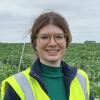What is canopy sensing?
Canopy sensing uses sensors to measure reflectance from the crop surface. This information is often presented in the form of a vegetation index. There are a range of vegetation indices that can be used – the most well-known is the Normalised Difference Vegetation Index (NDVI). Vegetation indices correlate with crop biomass and crop nitrogen uptake. There are a range of different platforms and methods for collecting crop canopy information including satellites, tractor mounted sensors and UAVs (Unmanned Aerial Vehicles) or drones.
How can we use information from canopy sensing?
Canopy sensing is most commonly used as a basis for variable rate nitrogen (N) applications. A crop with a well-developed thick canopy will have different N requirements to a crop with a less well-developed canopy. Information on the crop canopy can be used to vary the N rate across a field, usually by applying more N to thinner areas of the crop and less to thicker areas.
The data also provide a good overall picture of crop performance across fields and farms offering a ‘virtual’ field walk. Farm level crop canopy maps can be used to identify areas of underperforming crop and better target management interventions.
Understanding crop variability
Within-field variability is usually apparent on most farms. The challenge is to understand what factors are driving crop variability and which of these we can manage.
Sometimes the reason for crop variability may be clear, for example areas of lower soil pH, lower water holding capacity in lighter textured areas of the field or differences in soil structure, depth and drainage. However, if the reason for the variability is not clear, a targeted approach to soil and crop sampling in contrasting areas of good/poor performing crop can be useful.
If the causes of yield variation can be identified and eliminated, the yields in the low performing areas will increase resulting in ‘quick wins’ for all crops grown in the rotation. This approach is most effective for localised areas where limiting factors can be easily identified such as low pH and areas of poor soil drainage.
Final thought
Focussing on crop variability can help identify and address yield limiting factors. However, it may never be possible to eliminate the effect of soil variability on crop performance, particularly in inherently variable fields.





